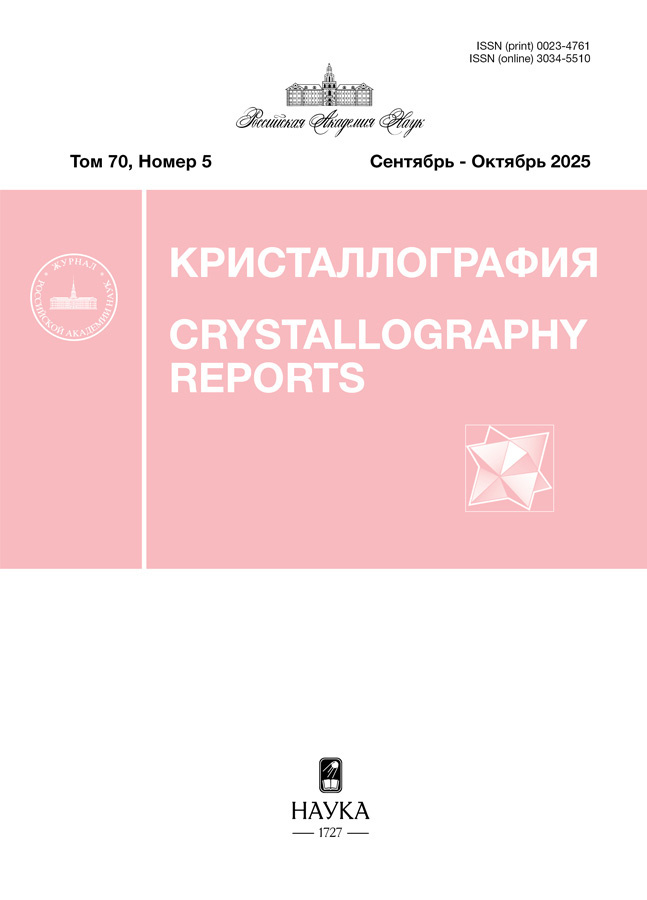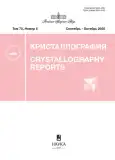A New Approach for Synthesizing Ultrathin Hexagonal Boron Nitride Nanoparticles Through Two-Step Thermal Treatment
- Authors: Abdurakhmonov O.E.1, Aripova M.H.1, Abdurakhmonov S.E.1,2, Ruzibaev B.R.1, Ruzmatov E.I.1, Kurbanov M.K.3, Saidov D.S.4, Juraev T.I.5, Sharopov U.B.6, Komolov A.S.7, Pronin I.A.8
-
Affiliations:
- Tashkent Institute of Chemical Technology
- Almalyk Branch of National Research Technological University “MISIS”
- Urgench State University
- Urgench Ranch Technology University
- KIMYO International University in Tashkent
- Physical-Technical Institute, Uzbekistan Academy of Sciences
- St-Petersburg State University
- Penza State University
- Issue: Vol 70, No 5 (2025)
- Pages: 830-836
- Section: НАНОМАТЕРИАЛЫ, КЕРАМИКА
- URL: https://modernonco.orscience.ru/0023-4761/article/view/693878
- DOI: https://doi.org/10.31857/S0023476125050149
- EDN: https://elibrary.ru/vgirvz
- ID: 693878
Cite item
Abstract
About the authors
O. E. Abdurakhmonov
Tashkent Institute of Chemical Technology100011, Tashkent, Uzbekistan
M. H. Aripova
Tashkent Institute of Chemical Technology100011, Tashkent, Uzbekistan
S. E. Abdurakhmonov
Tashkent Institute of Chemical Technology; Almalyk Branch of National Research Technological University “MISIS”100011, Tashkent, Uzbekistan; 110105, Almalyk, Uzbekistan
B. R. Ruzibaev
Tashkent Institute of Chemical Technology100011, Tashkent, Uzbekistan
E. I. Ruzmatov
Tashkent Institute of Chemical Technology100011, Tashkent, Uzbekistan
M. K. Kurbanov
Urgench State UniversityUrgench, Uzbekistan
D. S. Saidov
Urgench Ranch Technology UniversityUrgench, Uzbekistan
T. I. Juraev
KIMYO International University in TashkentTashkent, Uzbekistan
U. B. Sharopov
Physical-Technical Institute, Uzbekistan Academy of Sciences
Email: utkirstar@gmail.com
Tashkent, Uzbekistan
A. S. Komolov
St-Petersburg State UniversitySt. Petersburg, Russia
I. A. Pronin
Penza State UniversityPenza, Russia
References
- Oku T. Synthesis, Structures and Properties of Boron Nitride Nanoparticles. Cham: Springer International Publishing, 2015. 232 р. https://doi.org/10.1007/978-3-319-13188-7_9-1
- Óvári L., Farkas A.P., Palotás K. et al. // Surf. Sci. Rep. 2024. V. 79. P. 100637. https://doi.org/10.1016/J.SURFREP.2024.100637
- Naclerio A.E., Kidambi P.R. et al. // Adv. Mater. 2023. V. 35. P. 2207374. https://doi.org/10.1002/ADMA.202207374
- Wang J., Ma F., Liang W. et al. // Nanophotonics. 2017. V. 6. P. 976. https://doi.org/10.1515/nanoph-2017-0015
- Narayan J., Bhaumik A. // APL Mater. 2016. V. 4. P. 020701. https://doi.org/10.1063/1.4941095/120597
- Song J., Duan S., Chen X. et al. // Chin. Phys. Lett. 2020. V. 37. P. 076203. https://doi.org/10.1088/0256-307X/37/7/076203
- Li W., Luo T., Zhu C. et al. // Ind. Eng. Chem. Res. 2023. V. 62. P. 444. https://doi.org/10.1021/ACS.IECR.2C03639
- Anafcheh M., Ghafouri R. // J. Clust. Sci. 2014. V. 25. P. 1173. https://doi.org/10.1007/S10876-014-0698-0
- Afzal O., Shafi W.K., Charoo M.S. // Energy Sources. A. 2020. V. 47. P. 4128. https://doi.org/10.1080/15567036.2020.1864516
- Oku T. // B-C-N Nanotubes and Related Nanostructures. NY: Springer, 2009. P. 149. https://doi.org/10.1007/978-1-4419-0086-9_6
- Wang J., Ma F., Liang W. et al. // Mater. Today Phys. 2017. V. 2. P. 34. https://doi.org/10.1016/J.MTPHYS.2017.07.001
- Naresh Muthu R., Rajashabala S., Kannan R. et al. // Renew. Energy. 2016. V. 85. P. 394. https://doi.org/10.1016/J.RENENE.2015.06.056
- Charoo M.S., Wani M.F. // Lubr. Sci. 2017. V. 29. P. 254. https://doi.org/10.1002/LS.1366
- Kim T.H., Ko E.H., Nam J. et al. // J. Nanosci. Nanotechnol. 2017. V. 17. P. 9223. https://doi.org/10.1166/JNN.2017.13865
- Kayani Z.N., Bashir Z., Mohsin M. et al. // Optik (Stuttg.). 2021. V. 243. P. 167502. https://doi.org/10.1016/j.ijleo.2021.167502
- Queiroz S.M., Medeiros F.S., Silva G.G. et al. // Nanotechnol. 2022. V. 33. P. 035714. https://doi.org/10.1088/1361-6528/ac20ff
- Shaikh M., Ravi P., Roselina N.N. et al. // J. Eng. Tribol. 2024. V. 238. P. 1233. https://doi.org/101177/13506501241257560.
- Bae D.S., Kim C., Lee H. et al // Nano Converg. 2022. V. 9. P. 10. https://doi.org/10.1186/S40580-022-00312-Y/FIGURES/7
- Yuan Y., Weber J., Li J. et al. // Nat. Commun. 2024. V. 15. P. 12. https://doi.org/10.1038/s41467-024-48485-w
- Lin J., Tay R.Y., Li H. et al. // Nanoscale. 2018. V. 10. P. 16251. https://doi.org/10.1039/C8NR03984D
- Sutorius A., Weißing R., Rindtorff Pèrez C. et al. // Nanoscale. 2024. P. 16. V. 15792. https://doi.org/10.1039/D4NR02624A
- Prus A., Owarzany R., Jezierski D. et al. // Dalton Trans. 2024. V. 53. P. 8140. https://doi.org/10.1039/D4DT00682H
- Ma R., Bando Y., Sato T. // Chem. Phys. Lett. 2001. V. 337. P. 64. https://doi.org/10.1016/S0009-2614(01)00194-4
- Wagare D.S., Shirsath S.E., Shaikh M. et al. // Environ. Chem. Lett. 2021. V. 19. P. 3282. https://doi.org/10.1007/S10311-020-01176-6
- Kostoglou N., Polychronopoulou K., Rebholz C. // Vacuum. 2015. V. 112. P. 45. https://doi.org/10.1016/J.VACUUM.2014.11.009
- KInacI A., Haskins J.B., Sevik C. et al. // Phys. Rev. B. 2012. V. 86. P. 115410. https://doi.org/10.1103/PHYSREVB.86.115410/FIGURES/5/THUMBNAIL
- Liu F.H., Pang M. // Mater Today Commun. 2024. V. 39. P. 108601. https://doi.org/10.1016/J.MTCOMM.2024.108601
- Liu H., Yan M., Jing W. et al. // Diam. Relat. Mater. 2024. V. 148. P. 111410. https://doi.org/10.1016/J.DIAMOND.2024.111410
- Yang Y., Peng Y., Saleem M.F. et al. // Materials. 2022. V. 15. P. 4396. https://doi.org/10.3390/MA15134396
- Abdurakhmonov O., Sharopov U., Abdurakhmonov S. et al. // J. Magn. Magn. Mater. 2024. V. 600. P. 172130. https://doi.org/10.1016/J.JMMM.2024.172130
- Abdurakhmonov O.E., Sharopov U.B., Abdurakhmonov Sh.E. et al. // J. Magn. Magn. Mater. 2024. V. 589. P. 171562. https://doi.org/10.1016/j.jmmm.2023.171562
- Sharopov U., Samiev K., To’raev A. et al. // Vacuum. 2024. V. 227. P. 113395. https://doi.org/10.1016/J.VACUUM.2024.113395
- Абдурахмонов О.Э., Алисултанов М.Э., Вертаева Д.А. и др. // Журн. неорган. химии. 2022. Т. 67. № 7. С. 1032. https://doi.org/10.31857/S0044457X22070029
- Llenas M., Cuenca L., Santos C. et al. // Biomedicines. 2022. V. 10. P. 3238. https://doi.org/10.3390/BIOMEDICINES10123238/S1
- Bandarenka H., Burko A., Girel K. et al. // Crystals. 2023. V. 13. P. 749. https://doi.org/10.3390/CRYST13050749
- Komilov A., Abdulkhaev O., Nasrullayev Y. et al. // Appl. Sol. Energy. 2024. V. 60. P. 188. https://doi.org/10.3103/S0003701X24602059
- Revabhai P.M., Singhal R.K., Basu H. et al. // J. Nanostruct. Chem. 2022. V. 13. P. 41. https://doi.org/10.1007/S40097-022-00490-5
- Abdurakhmonov O.E., Alisultanov M.E., Abdurakhmonov Sh.E. et al. // Nanobiotech. Rep. 2023. V. 18. P. 232. https://doi.org/10.1134/S2635167623700064
- Tan Y., Yan X., Tang C. et al. // J. Mater. Sci.: Mater. Electron. 2021.V. 32. P. 23325. https://doi.org/10.1007/s10854-021-06817-2
- Paine R., Narula C. // Chem. Rev. 1990. V. 90. № 1. P. 73. https://doi.org/10.1021/cr00099a004
- McLean B., Page A.J. Boron Nitride Nanomaterials: Properties, Fabrication, and Applications. Jenny Stanford Publishing. 2023. 226 р. https://doi.org/10.1201/9781003314486
Supplementary files








